I'm experimenting with the Mega Archive format, so this isn't necessarily a return to regularly scheduled Mega Drive/Genesis rundowns quite yet. Previous entries included these huge blocks of data that largely repeated information already available on the wiki pages they linked to, so I've truncated the format to just include observations about each game and a few technical notes about their wiki presence. Let me know whether or not this "just the highlights" approach makes more sense going forward.
1993 would prove to be a peak of sorts for the Mega Drive as it involved the highest total number of releases across the year in Japan (1994 was the peak for American Genesis games released in one year). It would also be Sega's most successful year possibly ever, at least in their current incarnation as a hardware developer: 1994 would bring with it the disappointing 32X and Sega Saturn, in some way heralding their eventual end, but the worst thing to happen to Sega during 1993 was probably that Night Trap-inspired congressional hearing on video game violence (though getting slammed by oblivious politicians probably didn't hurt Sega of America's "not for kids or old people" marketing campaign) or their lawsuit with Acclaim.
Links back to the older format posts can be found right here:
| Part I: 001-020 (Oct '88 - Dec '89) | Part XI: 161-175 (Jul '91 - Aug '91) | Part XXI: 311-320 (Sep '92 - Oct '92) |
| Part II: 021-035 (Dec '89 - Mar '90) | Part XII: 176-190 (Aug '91 - Sep '91) | Part XXII: 321-330 (Oct '92) |
| Part III: 036-050 (Apr '90 - Jul '90) | Part XIII: 191-205 (Oct '91 - Nov '91) | Part XXIII: 331-340 (Oct '92 - Nov '92) |
| Part IV: 051-065 (Aug '90 - Oct '90) | Part XIV: 206-220 (Nov '91) | Part XXIV: 341-350 (Nov '92 - Dec '92) |
| Part V: 066-080 (Oct '90 - Dec '90) | Part XV: 221-240 (Dec '91) | Part XXV: 351-360 (Dec '92) |
| Part VI: 081-098 (Dec '90) | Part XVI: 241-255 (Jan '92 - Feb '92) | Part XXVI: 361-370 (Dec '92) |
| Part VII: 099-115 (Jan '91 - Mar '91) | Part XVII: 256-270 (Mar '92 - Apr '92) | Part XXVII: 371-381 (Dec '92) |
| Part VIII: 116-130 (Mar '91 - Apr '91) | Part XVIII: 271-285 (Apr '92 - Jun '92) | Part XXVIII: 382-390 (Jan '93 - Feb '93) |
| Part IX: 131-145 (May '91 - Jun '91) | Part XIX: 286-300 (Jul '92 - Aug '92) | - |
| Part X: 146-160 (Jun '91 - Jul '91) | Part XX: 301-310 (Aug '92 - Sep '92) | - |
Part XXVIII: 382-390 (January '93 - February '93)
382: George Foreman's KO Boxing (First Released January 1993 (NA))
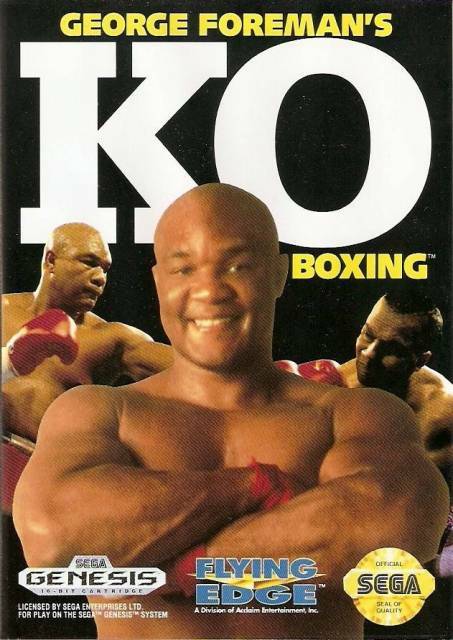
GameFactz:
- After his branded grill and naming all his sons George, the third most well-known George Foreman fact is that he used to box professionally. In this game from Beam Software he does exactly that, following the pattern of other boxing games with celebrity endorsements: the guy whose face is on the cover is the only actual human in the game, the others all fictional fodder to be beaten into submission.
- It has a connection to Sega's own '87 arcade boxer Heavyweight Champ: the version of George Foreman's KO Boxing that appeared on European home computers and 8-bit consoles was actually a Heavyweight Champ reskin. An earlier Genesis boxing game, James "Buster" Douglas Knockout Boxing, has a similar connection in that its 8-bit ports were based on Heavyweight Champ instead.
WikiFactz:
- We have our first of many double-dips for 1993 - Mega Drive games that shared a release with the SNES. That also means that, courtesy of the SNES project I undertook many moons ago, most of the wiki page was already complete. It just needed some Genesis-specific release info.
- Curiously, the date our wiki had was early 1992 (similar to GameFAQs's) when the most accurate source of info I could find was the February '93 issue of GamePro that purported that it had released in the January of that year instead, a few months after the SNES version. As always, I wish GameFAQs cited their sources so I could compare its veracity.
383: Operation Europe: Path to Victory 1939-45 (First Released 1993-01-16 (JP))
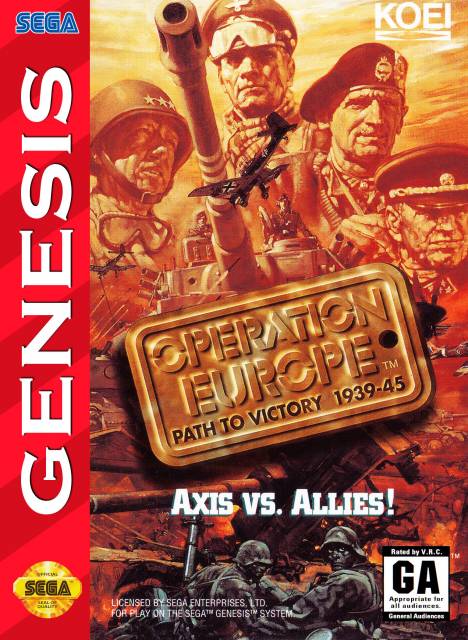
GameFactz:
- Part of Koei's series of strategy sims based around famous periods of war - the most famous of which being their Nobunaga's Ambition series set in the Japanese Sengoku era - Operation Europe follows the European front of WW2 with a few scenarios to pursue across those six years of conflict. As with other Koei games, it's fairly dense wargaming stuff that relies on the skill levels of your commanders to get anything done.
- Despite being set in Europe, there were no European releases of this game. Maybe Koei figured it was too soon?
WikiFactz:
- Another double-dip. Mega Drive and SFC releases were same-day (Jan '93), as were the American Genesis and SNES releases (June '94). A touch of parity less uncommon these days.
- The initial release date will need to be revisited. The game was on a bunch of Japanese home computers first, but I'm punting that wiki project way, way off into the future (as in, so far into the future that I'm hoping some MSX fanboy does it for me).
384: G-LOC: Air Battle (First Released 1993-01-21 (EU))
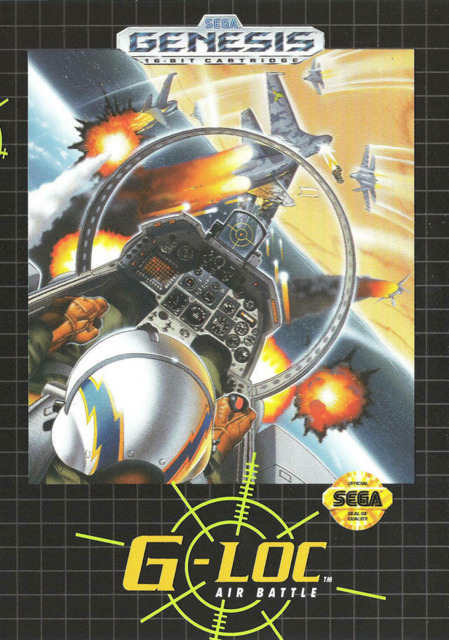
GameFactz:
- Developed as a semi-successor to After Burner, Sega wanted to go even further towards recreating the stomach-churning thrills of flying high-speed jets. G-LOC, which stands for "G-force-induced Loss Of Consciousness," was built with Sega's Y-Board arcade hardware for enhanced sprite-scaling and rotation and was available in a special "R-360" cabinet that could spin around to match the player vehicle's heading. Naturally, a lot of this didn't make it to the home versions.
- The Mega Drive port was actually developed by Probe Entertainment, a UK developer best known for its movie license games like T2: The Arcade Game and Alien³. It's not clear why Sega didn't develop it themselves, but it might be related to how it wasn't as popular as After Burner and thus an "after" thought. Might also explain why the EU/UK release is the first.
- The original arcade version is presently available on the Nintendo Switch as part of the Sega Ages series. It was released in 2020.
WikiFactz:
- Sega published the game so no double-dipping this time. The page just needed some Genesis screenshots, box art images, and releases for all three regions; nothing major. (I also capitalized the G-LOC in the title, since it's an acronym.) The core text was just peachy; a few of our power users have already checked the page out, possibly around the time when Jeff played it during his Sega anniversary stream last summer.
- You can call me anal (my favorite Paul Simon song) but I'm always a little reluctant to source a header image from a graphically-weaker port when it wouldn't take much to get an arcade screengrab directly from that Switch release. I'll leave it to whomever may have bought the game there, or maybe I'll find one on Nintendo's eShop site later.
385: Best of the Best: Championship Karate (First Released 1993-01-29 (JP))
GameFactz:
- Right off the bat, Best of the Best: Championship Karate has a couple of misnomers in its title: it has nothing to do with those Eric Roberts martial arts movies nor is it strictly about karate. It's a kickboxing game, and in its original European home computer form it was endorsed by French pro kickboxer Andre Panza. The TurboGrafx-16 port, of all versions, is the only console port to use this original title - I suspect that's because the TG16 had some small market penetration in France where the game was made.
- Speaking of which, the Mega Drive saw a huge amount of games developed by UK studios around this time but very few from across the rest of Europe. It's also possible Loriciel didn't develop the Mega Drive port, but no alternative exists that makes a more convincing case for itself. Loriciel is best known as a developer for obscure computer platforms: they are named for the Oric-1, a British computer that caught on in France, and they also developed games for Sega's short-lived SC-3000 computer for a time (France being one of the few regions where it was sold). French gaming history is some wild stuff.
WikiFactz:
- There's a thin line between sports games and fighter games when it comes to genre classifying one-versus-one martial arts games like this. I think the distinction right now concerns how a victor is determined: if you're just beating on the other dude until his health runs out it's probably a fighter, but if there's a point system at play or a specific win condition (say, a submission hold) it's a professional martial arts bout and therefore a sports game. Exceptions abound, however.
- Not a double-dip but a triple-dip: it appeared on both the SNES and TG16, both of which were the subjects of prior wiki projects. I'm currently on a mission to snap a shot of the ring girl that appears at the start of each round for every system (she looks a bit garbled on NES).
386: American Gladiators (First Released February 1993 (NA))
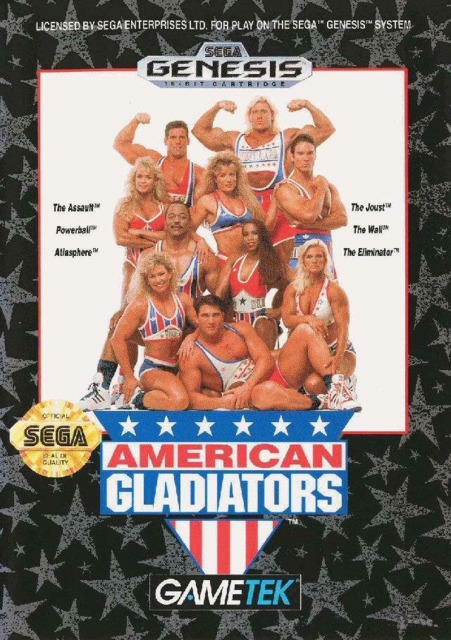
GameFactz:
- Regular people, or rather those who are considerably more in shape than regular people, take on a group of mononym "gladiators" in a series of athletic challenges for our televised entertainment. Losers get eaten by lions, though they stopped showing that part after the first season. Its multiple event format was ideal for a track-and-field type mini-game collection with plenty of the requisite button-mashing.
- It was developed by another UK studio, Imagitec Design, who presumably were sent a VHS recording of the show since it didn't air here (we had our own version that was pretty similar though). The game was never released in Europe. That's gotta be demoralizing for the staff, huh? Work eighteen months on a game and none of your friends and family get to see it.
WikiFactz:
- A double-dip. All it needed was release info.
- Another one with a dubious release date. The 8-bit version came out in 1991, but the best guess I could find for a Genesis release is 1993 - a considerable gap. Some sources, like GameFAQs, suggest an early 1992 release that would put the Genesis version closer to that NES debut but all the Genesis reviews I could find were dated mid-1993, with an issue of Sega Visions indicating a Feb 1993 release. I suspect publishers GameTek might not have been in a hurry to put it out (or tell anyone about it once it was).
387: Chester Cheetah: Too Cool to Fool (First Released February 1993 (NA))
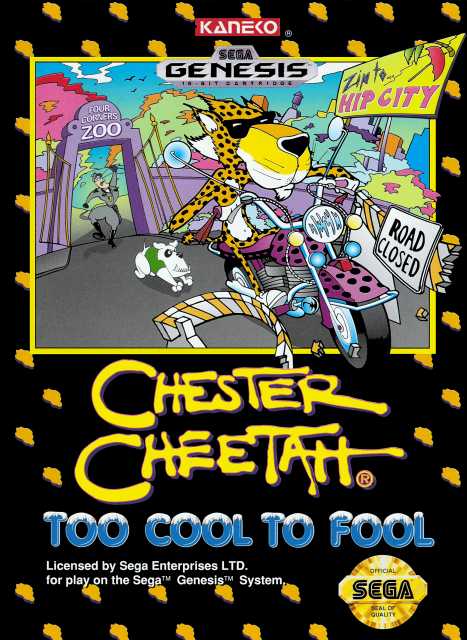
GameFactz:
- Is there anything more '90s than junk food mascot advergames? The incongruously in-shape Chester Cheetah represented Cheetos, the cheesy snack from Frito-Lay (a PepsiCo subsidiary), and like many mascots back then had little personality beyond "being cool". This game was one of the few opportunities to flesh the character out, giving him some equally cool animal friends - the Hip-O and Funky Monkey - and a nemesis in unscrupulous zookeeper Mean Eugene, from whose zoo Chester is trying to escape.
- There was a sequel a year later, Chester Cheetah: Wild Wild Quest (riffing on what was then a TV show from the 1960s, as if this whole enterprise didn't already reek of boomers), so I'm guessing the first game either sold well enough or at least pushed enough Cheetos.
- This is Kaneko's sixth game for the Mega Drive. Their previous was Deadly Moves, featuring everyone's favorite perpetually-terrified Hawaiian grappler Warren. Damn it, he should've been the Cheetos mascot.
- According to our own wiki page, the manual included a coupon for a bag of Cheetos (wow, how generous). Now I'm wondering how many Chester Cheetah: Too Cool to Fool manuals have a coupon-shaped hole in them, and if that's increased the MIB rarity value at all.
WikiFactz:
- We're double-dipping again, this time in fluorescent orange cheese powder. This week's been easy street.
- This is one of many pages I've come across where it has way more attention than it perhaps warrants; a user even submitted a stage-by-stage analysis. I'm way into all this. It's kinda what makes our wiki special.
388: Double Dragon 3: The Arcade Game (First Released February 1993 (NA))
GameFactz:
- The third outing of the Double Dragon brothers was not as well received as their first two games, in part because original developer Technos handed over development duties to a contractor. There was also some controversy with an item shop feature that required real currency to purchase upgrades; a feature that was removed or edited in later versions after some backlash.
- The original arcade game was developed by East Technology, with Technos being largely absent due to other projects. Technos would contribute to the NES version, however, which was developed in tandem as an independent entity in a fashion similar to the NES Strider. The Genesis port, distinct from the rest, was developed here in the UK by Software Creations: one of my hometown heroes, if not the most consistent in quality. 1993 would be a big year for them: they also put out Plok and Equinox, two of my low-key SNES favorites.
- The usual subtitle for Double Dragon 3 is "The Rosetta Stone": the Genesis port is called The Arcade Game is to distinguish it from the NES version, called Double Dragon III: The Sacred Stones.
- Yes, this is the game that called Billy "Bimmy" at one point during the intro. Sadly, that was only in the NES version.
WikiFactz:
- Not a double-dip (no SNES or TG16 ports) but I still didn't have to do much because this page is gargantuan. We have some dedicated Double Dragon fans in our wiki community, it seems.
- The Sacred Stones and The Rosetta Stone are technically different games, as discussed above, which creates an awkward scenario for our wiki in deciding whether to make them two separate pages or just keep them as one. It would require a lot of work to separate the two at this point and would probably be too confusing for anyone browsing the wiki looking for the third Double Dragon game, so for now I'm not making strides towards breaking them up, but it is a distinction that's going to matter enough to someone eventually. The Giant Bomb audience are huge dorks after all, which I mean in the nicest way.
389: Fatal Fury (First Released February 1993 (NA))
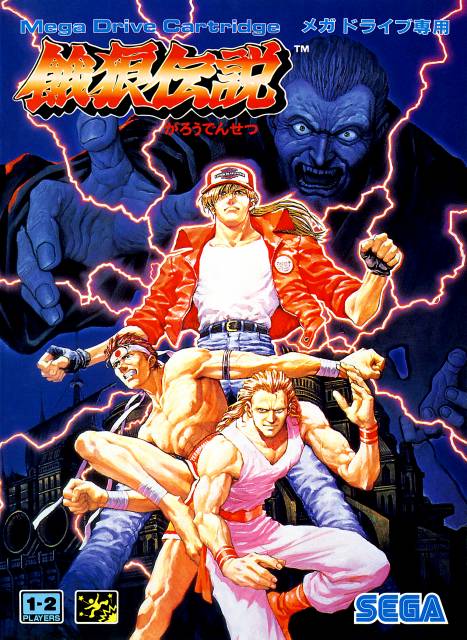
GameFactz:
- The SNK title that introduced the world to one of the most beloved fighter game characters - Duck King - found its way to the Mega Drive courtesy of Gaibrain, Aspect, and Takara. While some cuts from the Neo Geo version were inescapable, including stick-wielding sub-boss Billy Kane and Muay Thai kickboxer Hwa Jai, the Genesis version is one of the few to allow both players to select any character in Versus mode. Other versions, like the SNES, only allowed the second player that privilege: the first player had to be one of the three playable characters from the story mode (Andy Bogard, Terry Bogard, or Joe Higashi).
- The title screen actually includes the words "King of Fighters," but it's mostly a coincidence: the King of Fighters is what the in-game fighting competition is called. The first The King of Fighters game wouldn't appear until 1994, and was an Arcade/Neo Geo exclusive for many years.
- Evidence suggests Gaibrain did the lion's share of the porting work while Aspect worked on sound design. Gaibrain also worked with Aspect again on the sequel, Fatal Fury 2, as well as contributed to Sega's downgraded Virtua Fighter 2 Mega Drive port. This was Takara's first published Mega Drive game and would be followed by several more SNK fighter ports, including Samurai Shodown and King of the Monsters. Takara would become far more prevalent on the Sega Saturn and even put out some Sega Pico games.
- Also known as Garou Densetsu in Japan, or Legend of the Hungry Wolf. I don't think it has any wolves though, just Geese and Ducks.
WikiFactz:
- Might not surprise anyone to know we have a pretty detailed page on Fatal Fury and most of the SNK fighter library. It's a double-dip, but I don't remember having to add much back then either.
- The legacies of Fatal Fury and The King of Fighters have always intrigued me, even as someone with very little interaction with those games, and I sometimes wish we had the tech to track characters across both franchises with something like those flowcharts they used for those "Rock Family Tree" chronological breakdowns. I wouldn't know where to begin integrating an infographic format like that on the wiki though. Maybe those tables that some Wikipedia pages use for extant/prior band members would make more sense? Except our wiki doesn't really do horizontal tables that well... (Boy howdy I should stopped writing two sentences ago.)
390: Hit the Ice (First Released February 1993 (NA))
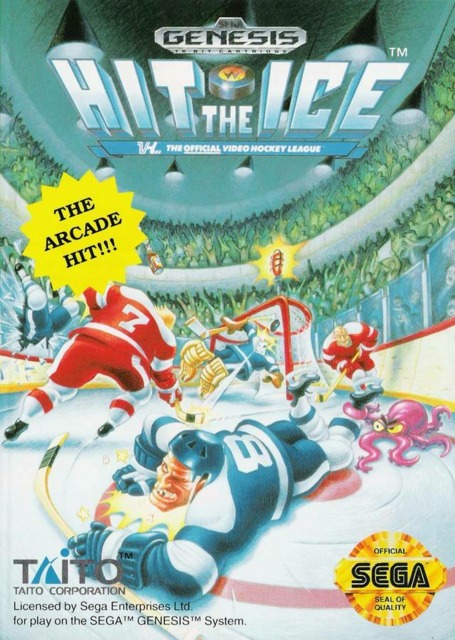
GameFactz:
- This one goes out to Jeff "@jerf" Bakalar, who talks about ice hockey on any day with a Y in its name already but more recently has been pining for the days of the arcade ice hockey game. Hit the Ice is no Blades of Steel, but it's part of the early '90s wave of sports games with more extreme violent angles to them, similar to the shoving and burning balls of NBA Jam or the bloody mayhem of the Mutant League series (both future Genesis mainstays).
- Williams developed the original game but Taito handled all the home versions, employing frequent contractor partners Aisystem Tokyo for the Genesis port. This would be Aisystem's last Mega Drive game but they'll pop up a few more times on the Mega CD.
WikiFactz:
- A triple-dip! SNES and TG16 represent. Hit the Ice also released on the Game Boy, but I'm not sure I'm prepared for that wiki project. Finding good header images alone is going to be a nightmare with a native 160x144 resolution.
- Managed to quash another Sports/[Sports] doubling-up. It's one of those wiki rules that makes no intuitive sense without a style guide saying which way to go - that is, whether you add the general "Sports" genre tag in addition to the genre tag for the specific sport ("Hockey" in this case). For the record, we don't include "Sports" if a more accurate genre tag exists: the purpose of the Sports tag is as an umbrella for every sport not already covered, like Lacrosse or Australian Rules Football or Jai Alai. (I hear Jai Alai 2K22 is going to be lit.)
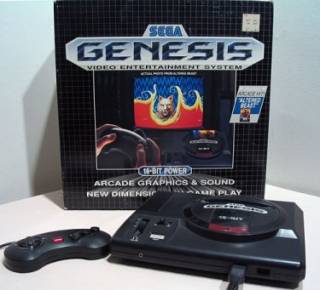
Log in to comment